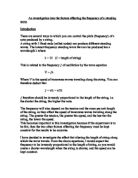What Is Fibre Optics
WHAT IS FIBRE OPTICS? To put it simply, fibre optics is a technology whereby a signal like video, data or voice, is concentrated on a light beam and sent down a glass tube over large distances, with very little distortion and loss. The principles of fibre optics are simple and easy to understand. All of us have seen the "broken straw" effect in a glass of water. When light travels from air to a denser medium, like glass for example, the light slows down by a factor equal to the optical index of the material and this slow down in speed results in bending of the light. As shown in the example when we see an object from underwater, the object is not in the actual position as we think because light bends travelling from water to air. When this angle of entry is increased, there would come a stage when the light is reflected back into the same medium, as shown in ray 3. This angle is called the angle of Total Reflection. Fibre Optics uses this simple principle for transmission. The core of the fibre optics cable, which is made of glass, has a higher index of refraction than the index of the cladding, which covers this core. So when light is injected into the glass core at the correct angle, it will reflect back from the surface and continue doing this in its forward direction of travel. In other words the light cannot "escape" from the fibre. COMPONENTS OF A FIBRE OPTICS
Investigation of the response of a microphone / loudspeaker over a range of frequencies
Investigation of the response of a microphone/loudspeaker over a range of frequencies Aim & Hypothesis To become proficient with using a signal generator and a Cathode Ray Oscilloscope (CRO.) Also, to investigate how the amplitude of a signal from a microphone varies as the frequency of a fixed amplitude signal applied to the loudspeaker varies, (between 100Hz and 1000Hz.) Safety RISK ASSESSMENT - LEVEL ONE This experiment does not carry many hazards. Bags and coats will be moved out of the way to ensure that no one will trip over them. The only other potential danger is as a result of using mains operated equipment. I will not be using the equipment near any water, taps etc. I will do a visual check on the equipment before use (not fraying or lose wires, etc.) Variables Independent Variable: Frequency (Hz) Dependent Variable: Amplitude (mV) I will be using the signal generator to alter the frequency being produced - therefore this will be the independent variable. This will alter the amplitude of the wave being shown on the CRO so this is the independent variable. I have used the same equipment throughout the experiment in order to ensure a fair test. Diagram Method The apparatus was set up as shown on the previous page. Firstly I did three 'checks' to ensure that (to check if they are properly calibrated.): * The amplitude of the signal remains constant *
Graphs illustrating variants of y = sin x.
Part 1 Graph 1 Graph 1 is showing y = sin x. Now lets look at the graphs of y = 2sin x ; y = ? sin x ; y = 5sin x y =2sin x Graph 2 y = 1/3sin x Graph 3 y = 5sin x Graph 4 If we compare graphs 2, 3 and 4 we can see that the number in front of sin (this number is called A) changes the vertical compression of the wave. When A<1 then the graph vertically compresses or amplitude becomes lower (graph 3) and when A>1 then graph expands vertically or amplitude becomes higher (graphs 2 and 4). If the number is 2, then the wave doubles vertically and when the number is 1/2 it compress by half. The comparison is of course made with the graph of sin x. Now let us see what happens when we make the equation negative by putting a minus sign in front of sin. By doing this we are taking A<0. Graph 5 Graph 5 shows us that the wave flips around when A is negative. So we can conclude that when A<0 the wave will always be upside down From investigating graphs of y = Asin x, we can conclude that when the A is less than 1 then the wave compresses vertically and when A is greater than 1 the wave expands vertically. If A is less than 0, then the whole wave flips upside down. To conclude we can say that A will equal to the number on the y-axis because

















